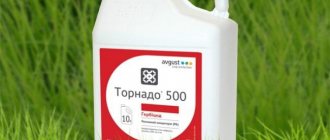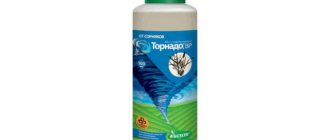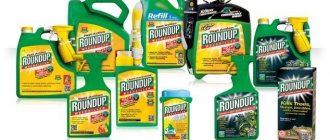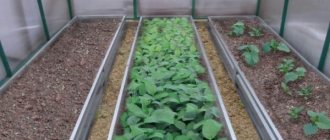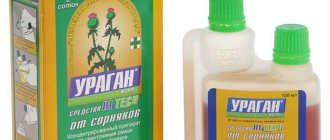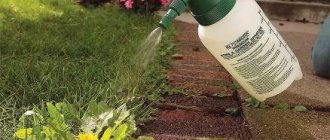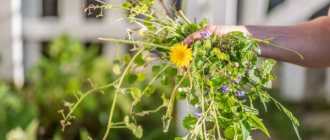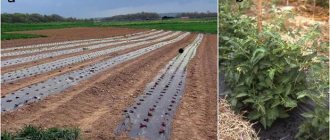An overgrown summer cottage is a pitiful and unattractive sight. One can hardly expect high yields here, so gardeners try to remove weeds in a timely manner. Weeding takes a lot of effort and time, but if you use the Tornado drug to help, things will go faster.
The domestically produced herbicide has successfully proven itself in agricultural farms, vegetable gardens, vineyards, and orchards. With its help, it is easier and more efficient to reclaim abandoned and overgrown areas, as well as work in areas where weeding is difficult.
Description and mechanism of action
It produces a product related to glyphosphate-containing herbicides, well-known Russian (Avgust). The drug is an aqueous solution with a concentration of the active substance of 500 g/l - glyphosphate (isopropylamine salt) acts as such. In its pure form, these are white crystals that are highly soluble in water.
In herbicides, glyphosphate is presented in the form of a salt; it works through contact with the above-ground parts of plants. The principle is simple: the active substance enters the tissues and cells of plants, disrupting the synthesis of phytohormones, phenols, amino acids and causing the death of crops. Externally it looks like this:
- change in color of leaf plates (yellowing);
- loss of turgor;
- drying out.
On a note! The product does not affect plant seeds.
The Tornado herbicide kit (for weeds) must include instructions for use, which indicate the dosage and consumption rates of the working solution. The drug is produced in ampoules (5 and 50 ml), in bottles (100 and 500 ml), in liter bottles, canisters (5-10 l). The price of a bottle (500 ml) is 700-800 rubles.
Composition of the substance
The basis of the drug is glyphosate, a pesticide used to destroy unwanted vegetation, as well as trees and shrubs. "Tornado" contains a high concentration of isopropylamine salt and is guaranteed to destroy more than 155 plant species. Thanks to its liquid form, the substance dissolves in water without residue and easily penetrates into plant cells.
Advantages and disadvantages
Reviews from farmers about the drug "Tornado", which allows you to do without a weed extractor, indicate its effectiveness. Among the advantages:
- effectiveness. When used correctly and following the manufacturer's recommendations, a good effect is achieved;
- the product works against a large number of weeds, shrubs, and trees;
- can be used on any type of soil;
- used as a desiccant on various agricultural crops (to accelerate crop ripening);
- safety in use;
- ease of use;
- Can be used over a wide temperature range.
Minuses:
- systemic drug of continuous (non-selective) action. Destroys all types of plants, including cultivated ones;
- strict adherence to dosages and consideration of weather conditions (precipitation) is required. If the doses are smaller, then the desired effect will not be obtained;
- The working solution cannot be stored.
What weeds does it affect?
In the list of crops that are most sensitive to poison:
- wheatgrass;
- stinging nettle;
- field thistle;
- meadow fescue;
- pig's finger;
- dandelion;
- bindweed;
- field clover;
- sow thistle and others.
Trees (birch, alder, aspen, willow) and shrubs (raspberry, rose hip, hawthorn) are processed.
“Tornado” shows a good effect when treating hydrophytes:
- sedge;
- cattail;
- cane;
- reed
Speed
The results of the herbicide are visible within a few days. The exact time depends on the type of crop:
- annuals - 5-6 days;
- perennials - 8-10 days;
- shrubs and young trees - 25-30 days.
The result is also influenced by the stage of development of weeds at the time of treatment. A slowdown in impact is observed when:
- low temperature;
- drought;
- rains.
Plants subject to the harmful effects of Hurricane Forte and Tornado
Perennials and annuals
What plants can be affected by Hurricane Forte and Tornado? Of course, they kill any annuals, but the preparations were created primarily as “heavy artillery” - to eradicate stubborn perennials (by the way, weed infusion is a very good fertilizer). They control the most “terrible” and tenacious ones - dandelion, wheatgrass, sow thistle. In addition - any weed grasses (bluegrass, timothy, fescue, foxtail, hedgehog, bromegrass, bentgrass), legumes (mouse peas, china), nettle, chamomile, clover, pigweed, tribulus, buttercups, oregano, yarrow. However, there is a circle of resistant species that die only partially: thistle, hogweed, bindweed, birch, gooseberry, burdock, St. John's wort, wormwood, marsh reed and cattail; It is better to deliver targeted, concentrated strikes against them.
What about trees and bushes?
Many people are interested in the question: is it possible to lime shrubs and even trees with the help of Tornado or Hurricane Forte? Weak concentrations are unlikely to cope with this, but it makes sense to try with strong doses - by spraying on young growth, by injecting into the trunks of larger specimens. It is unlikely to be completely destroyed, but it may have a partial effect above the surface of the earth. Willows, raspberries, birches, alders, and aspens are easier to harvest; cherry, maple, elm, and ash are more difficult.
Terms of use
There are nuances to using Tornado against weeds - reviews from farmers from various regions of the country show that it is important to choose the right growth phase of perennials. Glyphosphate herbicide is effective when the vegetative part of plants has grown, when the height is 13-20 cm. For example: in wheatgrass - at the 5-6 leaf stage, in bindweed and field thistle - at the beginning of flowering.
Do not treat areas in severe drought, heavy dew, or if the forecast predicts rain in 5-6 hours. Be sure to follow the dosage according to the regulations.
On a note! Do not reduce or increase the dosage of the drug, as this leads to undesirable consequences. It is prohibited to carry out treatments when the wind is more than 5 m/sec.
Spraying after rain is recommended, especially in very dusty areas. Precipitation will clean the surfaces of the leaves, after which the product will penetrate the plant tissue faster.
Be sure to control the quality of water for working solutions. Avoid the use of liquids with organic impurities and clay fractions. When using hard water, ammonium sulfate is added to soften production areas.
What additional weed control measures to use?
And really, what to do then? If strong drugs such as Tornado and Roundup do not help, or you are worried that their use will not be as effective as you expect, it is necessary to use comprehensive measures:
- After processing, start building special fences in the beds, for example, use slate digging to a depth of at least half a meter;
- Make high beds for tomatoes, cucumbers, peppers and other seedlings that you will plant in your summer cottage;
- Pay maximum attention to the row spacing, for example, even cover them with film, linoleum, paving slabs, fill them with gravel, and so on;
- Do not forget about the standard prevention of weeds on the site - remove only the emerging shoots by hand and with a hoe, uproot everything that you don’t like, and often remove the tops of the weeds so that they do not have time to produce seeds.
Instructions for use
Despite the fact that the chemical is effective over a wide range of temperatures, it is best to use the herbicide at +5 ºC…+25 ºC. In hot weather, the composition evaporates faster from the leaf blades, and at low temperatures it penetrates plant tissue more slowly.
Working solution
The standard concentration is 1-3%.
To do this, take 25 ml of herbicide and dilute it in three liters of water. The quantity is calculated to treat an area of 100 m². The dosage is given for annuals.
For perennial herbaceous plants, the proportions are increased to 50 ml, for shrubs and trees - to 75 ml. The amount of water remains the same - 3 liters (see video).
It is allowed to increase the volume with thickened and tall weeds (in production areas). In abandoned areas, an increased concentration is also used to kill weeds (75 ml per 3 liters of water).
Preparation of the solution
Step-by-step instruction:
- gently shake the ampoule or bottle;
- measure out the required amount of herbicide;
- fill the container ½ full with water;
- add the drug;
- add water and mix thoroughly.
The working solution is prepared immediately before treatment.
Line of drugs "Tornado"
Depending on the situation, it is easy to choose the right option. produces several types of herbicide "Tornado". All of them belong to glyphosphate agents and are used to control weeds:
- "Tornado" is an aqueous concentrated solution of continuous action, a universal solution. Glyphosphate content - 360 g/l. III hazard class. Not suitable for destroying hogweed and cow parsnip;
- herbicide "Tornado 500" - effective against biennials and perennials. The content of the active substance is 50 g/l. Suitable for autumn treatment of root shoot weeds and perennial rhizomatous crops;
- "Tornado 540" - contains 540 g/l of active substance. Universal herbicide, effective desiccant. Preparative form: aqueous solution.
For spraying in small areas, it is recommended to use Tornado Bau. Available in a bottle with a trigger spray (volume - 700 ml), inside there is a ready-made working solution (dilution is not required). The concentration of the active substance is 8.8 g/l.
The manufacturer also presented a new product - the herbicide “Tornado Extra”. This is a universal remedy for weeds of any type. In practice, the drug has shown good results against shrubs, as well as in the destruction of difficult-to-eradicate crops (for example, Sosnovsky's hogweed).
August "Agrokiller"
“Agrokiller” is a popular chemistry for grass and weeds. Distinctive features of the drug: they are sold in liquid form, packaged in a convenient bottle with a screw-on cap. Usually one bottle of Agrokiller is enough for three hundred square meters, but if you need to treat a smaller area, prepare a working solution, close the lid of the original packaging, and place the remaining chemical in a cool, dark place.
The main advantages of herbicides:
- penetration both through the weed leaf and through the root system;
- wide spectrum of action (destroys 99% of weeds in the middle zone);
- Until the next wave of weed sowing, the treated area is protected.
Rating 8 out of 10 Price: 1300 rub.
Go to the store
"Agrokiller" has a perceptible smell of household chemicals. To avoid inhaling it, prepare the working solution in an open area: here it is not felt or is felt very weakly. It is better to cultivate the soil at a wind speed of 4-5 m/s: this way the smell will quickly disappear.
Weed killer hazard class - III. The chemical does not pose a threat to humans. Attention: if you accidentally drink an herbicide, consult a doctor.
The approximate consumption of the product is 100-200 l/ha (working solution). "August" is generally economical and easy to use. The first signs of weed wilting are observed 4-5 days after treatment; complete extermination of weeds occurs after two to three weeks.
Compatibility
It is advisable not to use Tornado simultaneously with other herbicides, pesticides, and fungicides. According to the instructions, treatment together with the preparations “Magnum” and “Bi-58” is allowed.
The first refers to herbicidal compositions of selective (selective) action. Available in the form of water-dispersible granules based on metsulfuron-methyl.
Insecticide "Bi-58" is a concentrated emulsion based on dimethoate, used to kill harmful insects and mites.
If necessary, the combination of Tornado and nitrogen fertilizers is allowed. Fertilizers are mixed with a herbicide solution in the required proportions.
Precautions when working with herbicides
Diluted herbicides are not considered hazardous to humans or animals. But you should still carry out the work carefully, following the general rules for working with chemicals. It is especially important to protect your eyes, as their mucous membrane is sensitive to glyphosate.
Hurricane Forte concentrate is not kept at sub-zero temperatures; Above +35 is also not necessary.
It is recommended to store Tornado concentrate at a temperature not lower than -15 degrees and not higher than +40, preferably at moderate room temperature.
Security measures
The chemical belongs to class III; care should be taken when processing. Wear protective clothing, protect the nose and mouth with a bandage or respirator, eyes with goggles, and hands with gloves.
After treatment, the remaining solution is disposed of, clothes are washed, and a shower is required. It is prohibited to drink, eat, or smoke while working. If the composition gets on the skin or mucous surfaces, promptly rinse with clean water. If the solution is accidentally swallowed, induce vomiting, take any adsorbent and be sure to consult a doctor.
The price of the herbicide against weeds "Tornado" is low, if the instructions for use are followed, the product gives excellent results. At the same time, it does not accumulate in the soil and in fruits.
Ideal conditions for treatment with Tornado and Hurricane Forte herbicides
When and how
Excellent results are obtained in late summer or early autumn, a month (or at least half a month) before severe frosts. At this time, perennials drive food into the roots, preparing for winter. The weather is not cold, but not too hot either. The rains have washed away the dust from the leaves, but clear weather is expected ahead. We carry out the treatment late in the morning (after the dew has dried) or in the late afternoon (before the night dew), strictly observing the dosage. Many plants are vulnerable and are in the flowering stage in mid-summer.
Another good time for processing is the beginning of the season. We clear the areas of old dry grass, wait for the seeds to sprout and the weeds to grow from the roots. We spray when they grow at least 4-5 leaves. The area should be dug up only after 3-4 weeks. If this is done earlier, then many rhizomes will not have time to die and will germinate.
What to cook with and how to use it
To prepare the solution, take a non-metallic container, clean, soft water with a temperature of at least +15 degrees. We use it on the same day. We treat weeds with a fine spray in calm weather, thoroughly wetting the foliage. It is useless to spray the ground. We strictly do not allow it to come into contact with cultivated plants (if necessary, protect them with film), otherwise they will go “locomotive” along with the weeds. For single weeds, it is possible to apply the drug in a targeted manner with a brush: generously lubricate several leaves. After completing the work, wash the dishes twice with detergents.
